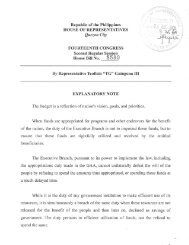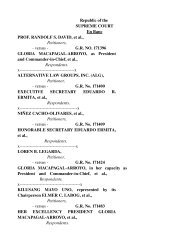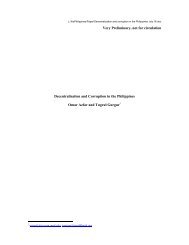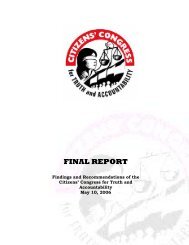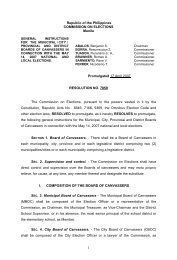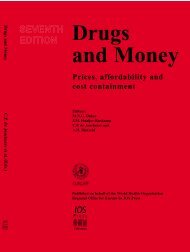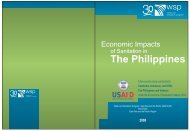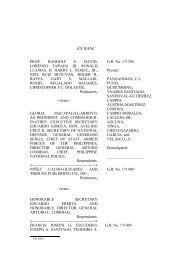Human Rights Committee - Philippine Center for Investigative ...
Human Rights Committee - Philippine Center for Investigative ...
Human Rights Committee - Philippine Center for Investigative ...
You also want an ePaper? Increase the reach of your titles
YUMPU automatically turns print PDFs into web optimized ePapers that Google loves.
their being poor, their sex (as far as girl prisoners are concerned), and of their tender<br />
age which render them defenseless and powerless to rise up in defense of their dignity<br />
and human rights in the face of the systematic, organized, and widespread onslaught by<br />
law en<strong>for</strong>cers acting under color of official authority and title from the President who is<br />
their commander-in-chief. This violates Article 26 as elucidated in <strong>Committee</strong> General<br />
Comment 28 (Paragraphs 3, 4, and 15).<br />
These state functionaries know and/or are in a position to know that these child<br />
prisoners are mostly unlettered, economically marginalized, and politically powerless;<br />
thus, enabling them to commit this institutionalized discrimination against child prisoners<br />
with impunity. The President, et. al., know and/or are in a position to know that these<br />
children are incapable of defending and protecting their rights amid the onslaughts from<br />
the law en<strong>for</strong>cers who tacitly and indirectly receive their orders from the <strong>Philippine</strong><br />
President, who is their Commander-in-Chief.<br />
The President refuses and fails to stop the institutionalized, widespread, and<br />
systematic jailing of children with adult crime suspects in police jails all over the<br />
<strong>Philippine</strong>s, save <strong>for</strong> Cebu City, victimizing some 20,000 children every year on a<br />
cumulative basis. This 20,000 figure is based on statistics on children accused of<br />
violating the law (CAVL) released by the Office of <strong>Philippine</strong> Senator Francis Pangilinan<br />
in 2003. The <strong>Philippine</strong> Public Attorney’s Office reported having provided free legal aid<br />
to 13,300 CAVL in 2002. For its part, the government’s Council <strong>for</strong> the Welfare of<br />
Children reported that, over a six-year period, there were 52,756 CAVL, from 1995 to<br />
2000.<br />
Despite the clamor from many sectors of society, the <strong>Philippine</strong> President fails<br />
and refuses to stop the incarceration of children with adult crime suspects in cramped<br />
police jails where the children, especially girl prisoners, face greater risks of torture,<br />
sodomy, rape, tattooing, and other despicable <strong>for</strong>ms of abuse both in the hands of their<br />
police captors and adult prisoners. Instead, the President blames the judiciary <strong>for</strong> the<br />
children’s prolonged detention as evidenced by her speech during the founding<br />
anniversary of the Volunteers Against Crime and Corruption held at the Rizal Hall in<br />
Malacanang last August 12.<br />
The President down to the law en<strong>for</strong>cers in the entire chain of command persist<br />
in carrying out this practice due to their retributive mindset, bias and prejudice, that<br />
manifest as a brazen <strong>for</strong>m of unlawful discrimination against children belonging to the<br />
poorest of the poor on account of their age, economic and social status, and in the case<br />
of girl prisoners, sex, on top of this age and other status discrimination.<br />
Data culled by the Coalition to Stop Child Detention Through Restorative Justice prove<br />
that all these children come from the ranks of children whose families’ income level falls<br />
below the poverty threshold as indicated by no less than the government’s own National<br />
Economic and Development Authority (NEDA).<br />
Most child prisoners come from 45.30 percent of the population living below the<br />
poverty threshold as of 1991. While NEDA statistics show a downtrend in poverty<br />
incidence – pegged at 40.60 percent in 1994, reduced to 34 percent in 2000, and curbed<br />
down further to 30.40 percent in 2003 – the phenomenon of child detention is actually<br />
worsening. Senator Jamby Madrigal, chairperson of the <strong>Philippine</strong> Senate’s <strong>Committee</strong><br />
on Youth, Women and Children, cites conservative estimates on the number of street<br />
children nationwide as reaching 1.5 million. About 50,000 of these children were<br />
49



